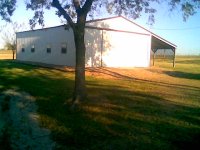Blstr88
Silver Member
Hey guys! My wife and I decided we'll be having a timber frame built next spring so Im going to start getting some quotes to have a slab poured this fall in preparation for the barn next spring. Couple questions...
- What is a real rough idea of price/sq ft I can expect to pay? I realize there are a lot of factors...Im just looking for a ballpark so I know if the quotes I get are reasonable or totally out there.
- I'll store the tractor in the barn, thats probably the heaviest thing...lots of garden tools, wood splitter, small chipper, etc...is a 6" slab necessary or can I get away with a 4"?
- If I have the slab done in the next few weeks but don't build the barn for 6-8 more months, is that ok? Any issue with leaving the slab outside in the elements all winter? Would I be better off waiting to do the slab until right before I plan to have the frame built?
Thanks guys! Really excited about this...we're going to go with a 16x24 timber frame barn, but Im going to have a 9' lean-to on each side. I'm going to close in at least one side so the barn will essentially be 25x24 and possibly leave the other side open to the elements (for stacking firewood under) but Ive considered possibly just closing in both sides so I'd be at 34x24 and then just build another lean-to off the back for the wood
- What is a real rough idea of price/sq ft I can expect to pay? I realize there are a lot of factors...Im just looking for a ballpark so I know if the quotes I get are reasonable or totally out there.
- I'll store the tractor in the barn, thats probably the heaviest thing...lots of garden tools, wood splitter, small chipper, etc...is a 6" slab necessary or can I get away with a 4"?
- If I have the slab done in the next few weeks but don't build the barn for 6-8 more months, is that ok? Any issue with leaving the slab outside in the elements all winter? Would I be better off waiting to do the slab until right before I plan to have the frame built?
Thanks guys! Really excited about this...we're going to go with a 16x24 timber frame barn, but Im going to have a 9' lean-to on each side. I'm going to close in at least one side so the barn will essentially be 25x24 and possibly leave the other side open to the elements (for stacking firewood under) but Ive considered possibly just closing in both sides so I'd be at 34x24 and then just build another lean-to off the back for the wood
